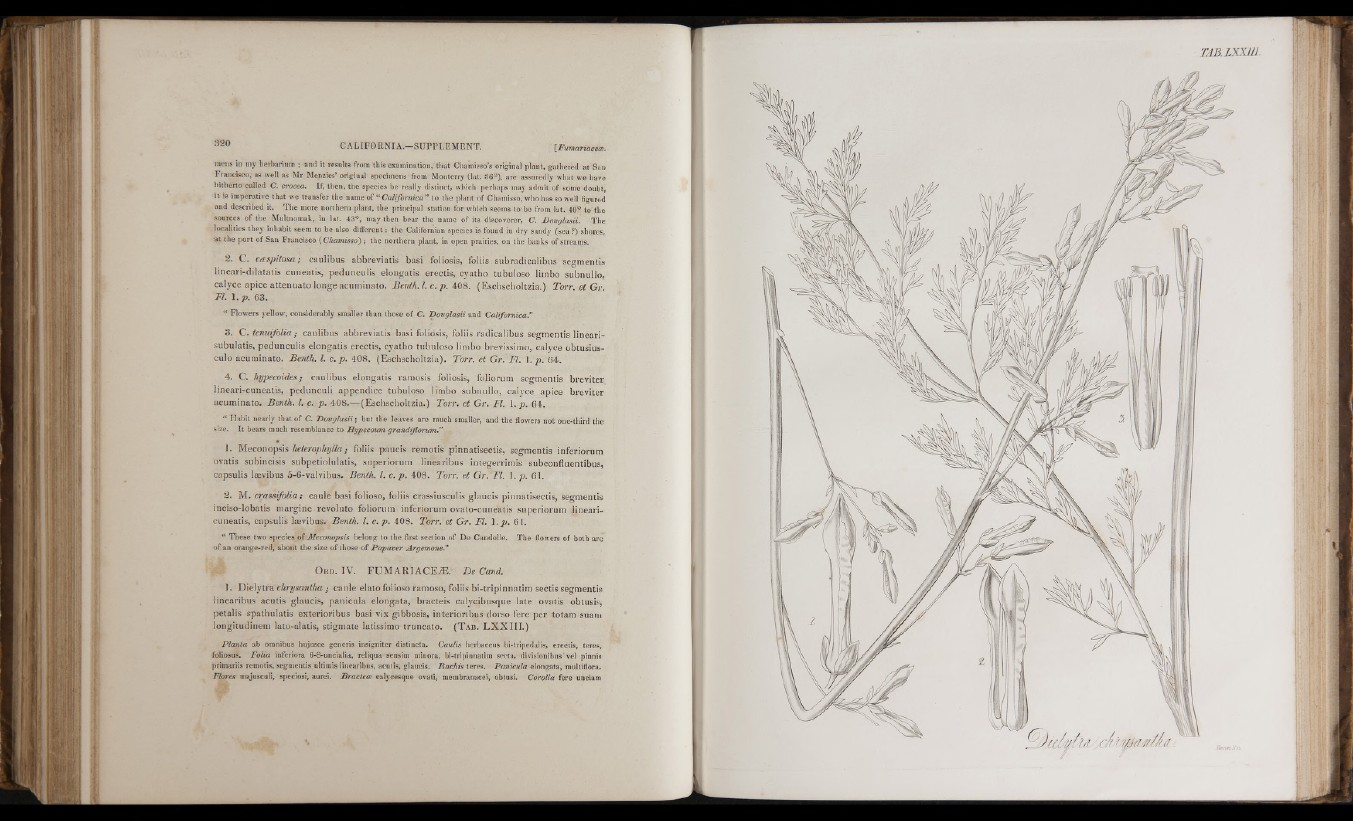
1
S'
■ t
I f
t t
mens in my herbarium ; and it results from this examination, tliat Chamisso’s original plant, gathered at San
Francisco, as well as Mr Menzies’ original specimens from Monterry (lat. 36°), are assuredly what we have
hitherto called C. a-ocea. If, tlieii, tlie speeies be really distinct, wl'ieh perha])s may admit of some doubt,
it is imperative that we transfer the name of “ Ca/r/orntca ” to the plant of Chamisso, who has so well figured
and described it. The more northern plant, the principal station for which seems to-be from lat. 40° to the
sources of tbe Multnomak, in lat. 43°, may then bear the name of its discoverer, C. Douglasii. The
localities they inhabit seem to be also different : the Californian species is found in ilry sandy (sea ?) shores,
at the port of San Francisco (Chamisso) ; the northern plant, in open prairies, on the banks of streams.
2. C. cæspitosa; caulibus abbreviatis basi foliosis, foiiis subradicalibus segmentis
lineari-dilatatis cuneatis, pedunculis elongatis erectis, cyatho tubuloso limbo subnullo,
calyce apice atten u ato longe a cuminato. Benth, L c. p . 498. {Eschscholtzia.) Torr. et Gr.
Fi. i . p . 63.
“ Flowers yellow, considerably smaller than those of C. Douglasii and Californica.”
3. C. tenuifolia • caulibus abbreviatis basi fol iosis, foliis radicalibus segmentis lineari-
subulatis, pedunculis elongatis erectis, cyatho tubuloso limbo brevissimo, calyce obtusiusculo
acuminato. Benth. I c .p . 4 0 8 . (E.schschokzia). Torr. et Gr. Fl. \ . p . 6 4 .
4. C. hypecoides; caulibus elongatis ramosis foliosis, foliorum segmeniis breviter
Jineari'Cuneatis, pedunculi appendice tubuloso limbo subnullo, calyce apice breviter
acuminato. Benth. I. c. p . 4 0 8 .— (Eschscholtzia.) Torr. et Gr. Fl. 1. p. 6 4 .
“ Habit nearly that of C. Douglasii ; but tbe leaves are much smaller, aud the flowers not one-third the
size. It bears much resemblance to Hi/pecoum grandiflorum.”
1. Meconoipús heterophjlla ; foliis paucis remotis pinnatisectis, segmentis inferiorum
ovatis subincisis subpetiolulatis, superiorum linearibus integerrimis subconfluentibus,
capsulis lævibus 5-6-valvibus. Benth. I. c .p . 4 0 8 . Torr. et Gr. Fl. \ . p . 61.
2. M . crassifolia; caule basi folioso, folii.s crassiusculis glaucis pinnatisectis, segmentis
inciso-lobatis margine revoluto foliorum inferiorum ovato-cuueaiis superiorum lineari-
cuneatis, capsulis lævibus. Benth. 1. c. p . 468. Torr. et Gr. FL \ . p . 6 \ .
“ These two species oi Meconopsis belong (o the first section of De Candolle. The flowers of both are
of an orange-red, abont the size of those of Papaver Argemone.”
O r d . IV. FU M A R IA C EÆ . D e Cand.
1. D ie ly tra chrysantha ¡ caule elato folioso ramoso, foliis b i-tripinnatim sectis segmentis
linearibus acutis glaucis, panicula elongata, bracteis calycibusque late ovatis obtusis,
petalis spathulatis exterioribus basi vix gibbosis, interioribus dorso fere p e r totam suam
longitudinem lato-alatis, stigmate latissimo truncato. ( T a b . L X X I I I .)
Planta ab omnibus hujusce generis insigniter distincta. Caulis herbaceus bi-tripodalis, erectis, teres,
foliosus. Folia inferiora 6-S-uncÌalid, reliqua sensim minora, bi-tripinnatim secta, divi.sionibus vel pinnis
primariis remotis, segmentis ultimis linearibus, acutis, glaucis. Hachis teres. Panicula elongata. mutcifiora.
Flores majusculi, speciosi, aurei. Bracteoe calycesque ovati, membranacei, obtusi. CoroUa fere unciam
r A B . L x x n i .